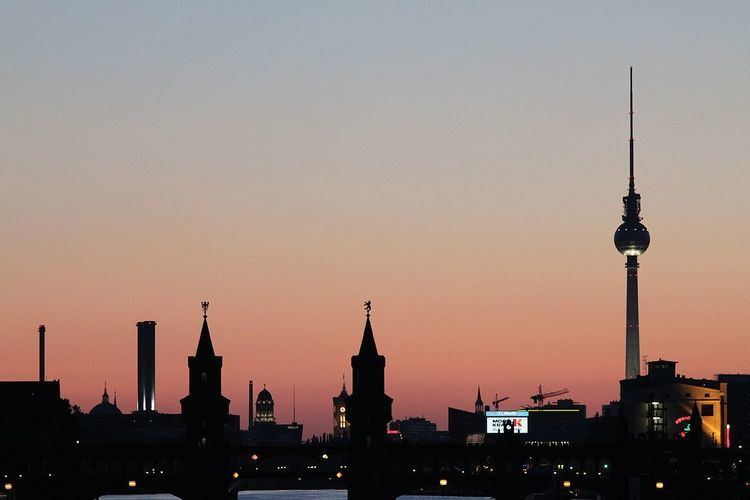 | ||
In December 2015, the city-state of Berlin had a population of 3,520,031 registered inhabitants in an area of 891.82 square kilometers (344.33 sq mi). The city's population density was 3,944 inhabitants per km². Berlin is Germany's largest city and the second most populous city in the European Union.
Contents
- History
- Municipality
- Urban area
- Metropolitan area
- Population
- Nationalities
- Employment
- Languages
- Religions
- References
In December 2015, 621,075 registered residents were of foreign nationality, originating from approximately 190 different countries.
History
The city responded to the 1685 revocation of the Edict of Nantes in France with the Edict of Potsdam, which guaranteed religious freedom and tax-free status to French Huguenot refugees for ten years. The 1920 Greater Berlin Act incorporated many suburbs and surrounding cities, forming most of the region comprising modern Berlin. The act increased the area of Berlin from 66 km2 (25 sq mi) to 883 km2 (341 sq mi) and its population from 1.9 million to 4 million.
Asylum policies in West Berlin triggered waves of immigration during the 1960s and 1970s. Berlin is home to about 250,000 Turks (especially in Kreuzberg, Neukölln and Wedding, a locality in the borough of Mitte), the largest Turkish community outside Turkey.
During the 1990s, the Aussiedlergesetze enabled immigration to Germany of residents of the former Soviet Union. Ethnic Germans from countries from the former Soviet Union make up the largest portion of the Russian-speaking community. Immigration continues from a number of Western countries, particularly by young people from Germany and other parts of Europe.
Municipality
On 31 December 2015 the city-state of Berlin had a population of 3,520,031 registered inhabitants in an area of 891.85 km2 (344.35 sq mi). Berlin in 2009 was estimated to have another 100,000 to 250,000 non-registered inhabitants. The city's population density was 4,048 inhabitants per km2. Berlin is the second most populous city proper in the EU.
Urban area
The urban area of Berlin comprised about 4.1 million people in 2014 in an area of 1,347 km2 (520 sq mi), making it the seventh most populous urban area in the European Union. The urban agglomeration of the metropolis was home to about 4.5 million in an area of 5,370 km2 (2,070 sq mi).
Metropolitan area
As of 2014 the functional urban area was home to about 5 million people in an area of approximately 15,000 km2 (5,792 sq mi). The entire Berlin-Brandenburg capital region has a population of more than 6 million in an area of 30,370 km2 (11,726 sq mi).
Population
In 2014, the city state Berlin had 37,368 live births (+6.6%), a record number since 1991. The number of deaths was 32,314. Almost 2 million households were counted in the city. 54 percent of them were single-person households. More than 337,000 families with children under the age of 18 lived in Berlin. In 2014 the German capital registered a migration surplus of approximately 40,000 people.
Nationalities
As of December 2013 there were approximately 1,000,000 people (about 30 percent of the population) with an immigrant background living in Berlin, with significant differences in their distribution. The immigrant community is diverse, with Middle Easterners (including Turks and Arabs), smaller numbers of East Asians, Sub-Saharan Africans and other European immigrants, Eastern Europeans forming the largest groups. Since the accession of Romania and Bulgaria to the European Union there has been a Romani influx. About 70,000 Afro-Germans live in Berlin.
There are more than 25 non-indigenous communities with a population of at least 10,000 people, including Turkish, Polish, Russian, Croatian, Palestinian, Serbian, Italian, Bosnian, Vietnamese, American, Romanian, Bulgarian, Chinese, Austrian, Ghanaian, Ukrainian, French, British, Spanish, Israeli, Thai, Iranian, Egyptian and Syrian communities.
Employment
In 2015, the total labour force in Berlin was 1.85 million. The unemployment rate reached a 24-year low in November 2015 and stood at 10.0% . From 2012–2015 Berlin, as a German state, had the highest annual employment growth rate. Around 130,000 jobs were added in this period.
Languages
German is the official and predominant spoken language in Berlin. It is a West Germanic language that derives most of its vocabulary from the Germanic branch of the Indo-European language family. German is one of 24 languages of the European Union, and one of the three working languages of the European Commission.
Berlinerisch or Berlinisch is a variety with influence of Lausitzisch-neumärkisch. It is spoken in Berlin and the surrounding metropolitan area. It originates from a Mark Brandenburgish variant. The dialect is now seen more as a sociolect, largely through increased immigration and trends among the educated population to speak standard German in everyday life.
The most commonly spoken foreign languages in Berlin are English, Turkish, Russian, Arabic, Polish, Kurdish, Vietnamese, Serbian, Croatian, Greek, and other Asian languages.
Turkish, Arabic, Kurdish, Serbian and Croatian are heard more often in the western part, due to the large Middle Eastern and former-Yugoslavian communities; Vietnamese, Russian and Polish have more native speakers in eastern Berlin. English, Vietnamese, Russian, and Polish have more native speakers in eastern Berlin.
Religions
More than 60% of Berlin residents have no registered religious affiliation. The largest denomination in 2010 was the Protestant regional church body – the Evangelical Church of Berlin-Brandenburg-Silesian Upper Lusatia (EKBO) – a United church. EKBO is a member of the Evangelical Church in Germany (EKD) and Union Evangelischer Kirchen (UEK), and accounts for 18.7% of the local population. The Roman Catholic Church has 9.1% of residents registered as its members. About 2.7% of the population identify with other Christian denominations (mostly Eastern Orthodox, but also various Protestants).
An estimated 200,000–350,000 Muslims reside in Berlin, making up about 6–10 percent of the population. 0.9% of Berliners belong to other religions. Of the estimated population of 30,000–45,000 Jewish residents, approximately 12,000 are registered members of religious organizations.
